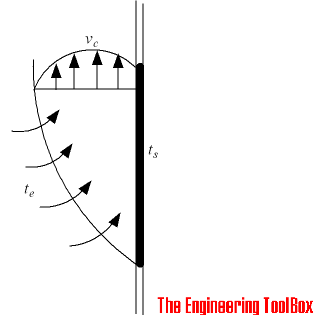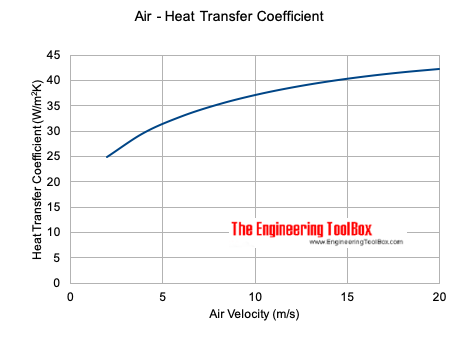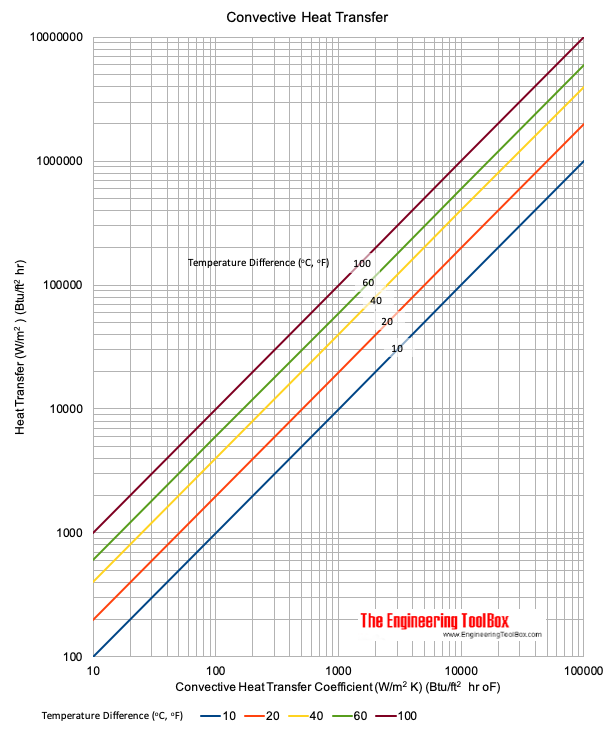Convective Heat Transfer
Heat transfer between a solid and a moving fluid is called convection. This is a short tutorial about convective heat transfer.
Heat energy transferred between a surface and a moving fluid with different temperatures - is known as convection.
In reality this is a combination of diffusion and bulk motion of molecules. Near the surface the fluid velocity is low, and diffusion dominates. At distance from the surface, bulk motion increases the influence and dominates.

Convective heat transfer can be
- forced or assisted convection
- natural or free convection
Forced or Assisted Convection
Forced convection occurs when a fluid flow is induced by an external force, such as a pump, fan or a mixer.
Natural or Free Convection
Natural convection is caused by buoyancy forces due to dens ity differences caused by temperature variations in the fluid. At heating the density change in the boundary layer will cause the fluid to rise and be replaced by cooler fluid that also will heat and rise. This continues phenomena is called free or natural convection.
Boiling or condensing processes are also referred to as a convective heat transfer processes.
- The heat transfer per unit surface through convection was first described by Newton and the relation is known as the Newton's Law of Cooling.
The equation for convection can be expressed as:
q = hc A dT (1)
where
q = heat transferred per unit time (W, Btu/hr)
A = heat transfer area of the surface (m2, ft2)
hc = convective heat transfer coefficient of the process (W/(m2oC, Btu/(ft2 h oF))
dT = temperature difference between the surface and the bulk fluid (oC, F)
Heat Transfer Coefficients - Units
- 1 W/(m2K) = 0.85984 kcal/(h m2 oC) = 0.1761 Btu/(ft2 h oF)
- 1 Btu/(ft2 h oF) = 5.678 W/(m2 K) = 4.882 kcal/(h m2 oC)
- 1 kcal/(h m2 oC) = 1.163 W/(m2K) = 0.205 Btu/(ft2 h oF)
Convective Heat Transfer Coefficients
Convective heat transfer coefficients - hc - depends on type of media, if its gas or liquid, and flow properties such as velocity, viscosity and other flow and temperature dependent properties.
Typical convective heat transfer coefficients for some common fluid flow applications:
- Free Convection - air, gases and dry vapors : 0.5 - 1000 (W/(m2K))
- Free Convection - water and liquids: 50 - 3000 (W/(m2K))
- Forced Convection - air, gases and dry vapors: 10 - 1000 (W/(m2K))
- Forced Convection - water and liquids: 50 - 10000 (W/(m2K))
- Forced Convection - liquid metals: 5000 - 40000 (W/(m2K))
- Boiling Water : 3.000 - 100.000 (W/(m2K))
- Condensing Water Vapor: 5.000 - 100.000 (W/(m2K))
Convective Heat Transfer Coefficient for Air
The convective heat transfer coefficient for air flow can be approximated to
hc = 10.45 - v + 10 v1/2 (2)
where
hc = heat transfer coefficient (kCal/m2h°C)
v = relative speed between object surface and air (m/s)
Since
1 kcal/m2h°C = 1.16 W/m2°C
(2) can be modified to
hcW = 12.12 - 1.16 v + 11.6 v1/2 (2b)
where
hcW = heat transfer coefficient (W/m2°C)
Note! - this is an empirical equation and can be used for velocities 2 to 20 m/s.

Example - Convective Heat Transfer
A fluid flows over a plane surface 1 m by 1 m. The surface temperature is 50oC, the fluid temperature is 20oC and the convective heat transfer coefficient is 2000 W/m2oC. The convective heat transfer between the hotter surface and the colder air can be calculated as
q = (2000 W/(m2oC)) ((1 m) (1 m)) ((50 oC) - (20 oC))
= 60000 (W)
= 60 (kW)
Convective Heat Transfer Calculator
Convective Heat Transfer Chart
Related Topics
-
Heat Loss and Insulation
Heat loss from pipes, tubes and tanks - with and without insulation. Use of materials lke foam, fiberglass, rockwool and more. -
Insulation and Heat Loss from Steam and Condesate Pipe Lines
Heat loss from uninsulated and insulated steam and condensate pipes and tanks. Calculate insulation thicknesses. -
Thermodynamics
Work, heat and energy systems.
Related Documents
-
Arithmetic and Logarithmic Mean Temperature Difference
Arithmetic Mean Temperature Difference in Heat Exchangers - AMTD - and Logarithmic Mean Temperature Difference - LMTD - formulas with examples - Online Mean Temperature Calculator. -
Condensation of Steam - Heat Transfer
Heat transfer when steam condensates. -
Conductive Heat Transfer
Conductive heat transfer takes place in a solid if there is a temperature gradient. -
Convective Air Flow - Single Heat Source
Calculate the vertical air flow and air velocity generated by a single heat source. -
Convective Air Flow from Heat Source
Convective air flows from typical heat sources like people, computers, radiators and more. -
Convective Heat Transmission - Air Velocity and Air Flow Volume
Hot or cold vertical surfaces generates vertical air flows - calculate air velocity and volume flow. -
Energy Transfer Equation
Fluid energy transfer. -
Heat Exchangers - Fouling and Reduced Heat Transfer
Heat-transfer in heat exchangers are reduced by fouling. -
Heat Exchangers - Overall Heat Transfer Coefficients
Overall heat transfer coefficients in common heat exchanger designs - tubular, plate or spiral. -
Heat Transfer Coefficients in Heat Exchanger Surface Combinations
Average overall heat transmission coefficients for fluid and surface combinations like Water to Air, Water to Water, Air to Air, Steam to Water and more. -
Overall Heat Transfer Coefficients
Walls or heat exchangers - calculate overall heat transfer coefficients. -
Wind Chill Index
Effective Temperature of air in movement.





